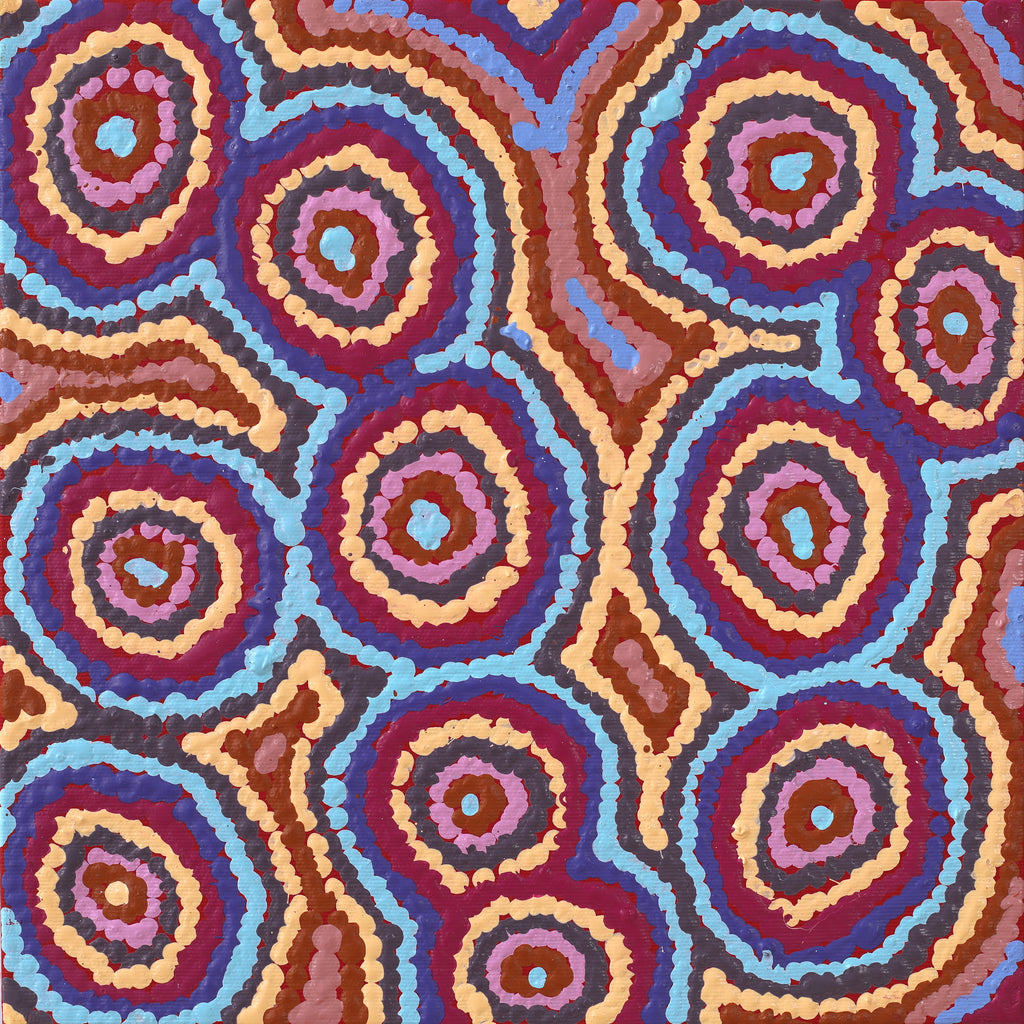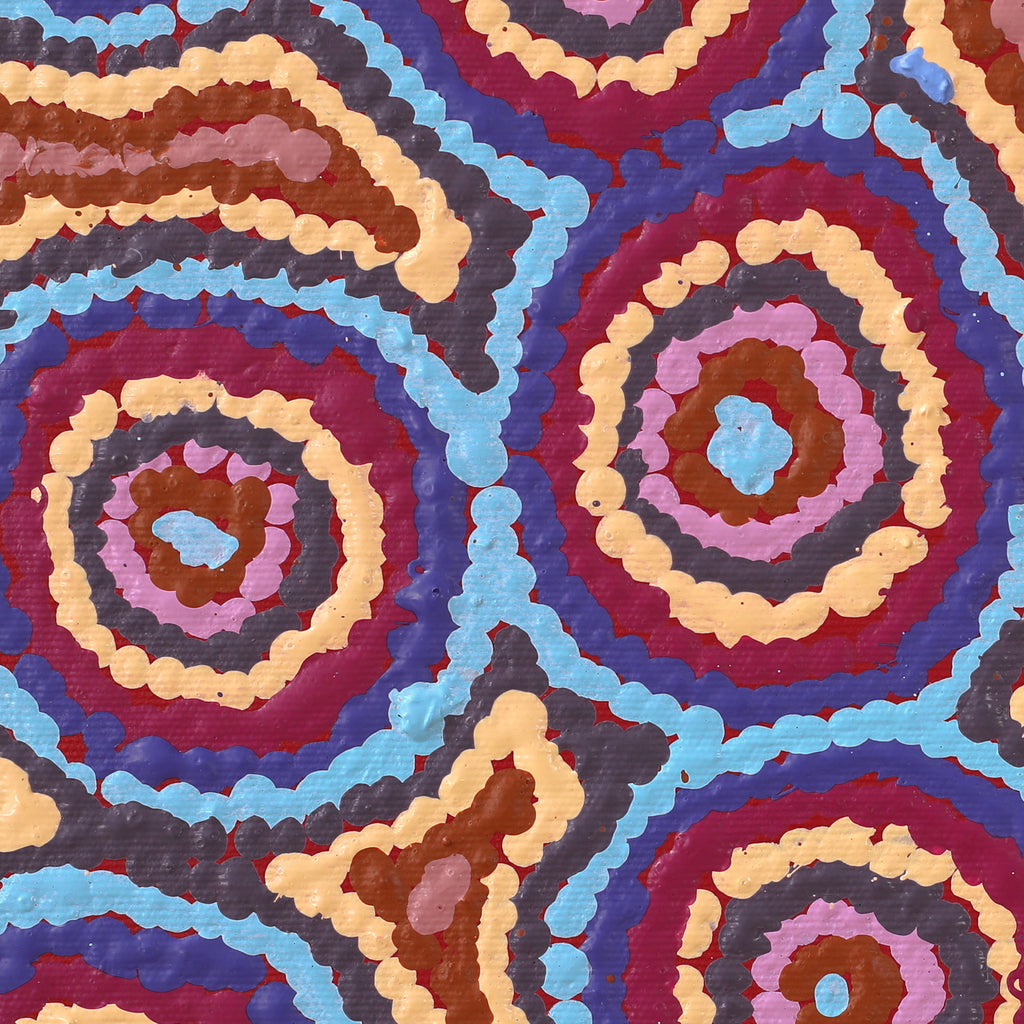




Sarah Napaljarri Sims, Mina Mina Jukurrpa (Mina Mina Dreaming), 30x30cm
Your support helps the artist and their community art centre.
Free insured post & 120-day returns Ships from Tasmania within 1 business day Arrives in 1–3 days (Aus) · 5–10 days (Int’l*) Guaranteed colour accuracy
Community Certified Artwork
This original artwork is sold on behalf of the community-run art centre. It includes their Certificate of Authenticity.
– Original 1/1
- Details
- Artwork
- Artist
- Aboriginal Artist - Sarah Napaljarri Sims
- Community - Nyirripi
- Aboriginal Art Centre - Warlukurlangu Artists Aboriginal Corporation
- Catalogue number - 2641/20ny
- Materials - Acrylic on pre-stretched canvas
- Size(cm) - H30 W30 D3.5
- Postage variants - Posted stretched and ready to hang
- Orientation - Painted from all sides and OK to hang as wished
Mina Mina is an extremely important ceremonial site for Napangardi and Napanangka women that is located approximately 600kms west of Yuendumu, just east of Lake Mackay and the WA border. The area has a ‘marluri’ (salt lake or claypan) that is usually dry, without water. There are also a number of ‘mulju’ (soakages), sandhills, and a large stand of ‘kurrkara’ (desert oaks [Allocasuarina decaisneana]). The Mina Mina Jukurrpa is an important source of Warlpiri ritual knowledge and social organization, particularly relating to the different roles performed by men and women.
The ‘kirda’ (owners) of this country are Napangardi/Napanangka women and Japangardi/Japanangka men, who can depict portions of the Mina Mina Jukurrpa in their paintings. There are a number of different components of the Mina Mina Jukurrpa; artists usually choose to depict one particular aspect. These can include ‘karnta’ (women), ‘karlangu’ (digging sticks), ‘majardi’ (hairstring skirts/tassels), ‘ngalyipi’ (snakevine [Tinospora smilacina]), ‘jintiparnta’ (desert truffle [Elderia arenivaga]), and ‘kurrkara’ (desert oak [Allocasuarina decaisneana]).
The Mina Mina Jukurrpa tells the story of a group of ancestral ‘karnta’ (women) who traveled from west to east. In the Dreamtime, these ancestral women danced at Mina Mina and ‘karlangu’ (digging sticks) rose up out of the ground. They collected these digging sticks and started travelling to the east. They carried their digging sticks over their shoulders and they were adorned with ‘majardi’ (hairstring belts), white feathers, and necklaces made from ‘yinirnti’ (bean tree [Erythrina vespertilio]) seeds. They continuously anointed themselves with ‘minyira’ (shiny fat) to increase their ritual powers as they went along. As the women travelled, they were followed by a ‘yinkardakurdaku’ (spotted nightjar [Eurostopodus argus]) from the Jakamarra subsection. The bird would call out and then hide in the bushes behind them as they travelled.
When the women danced at Mina Mina, they created a large dust cloud that swept up the ‘walyankarna’ (snake ancestors). The ‘walyankarna’ had previously transformed themselves from witchetty grubs into snakes at Kunajarrayi (Mount Nicker, 200km southwest of Yuendumu), and they had stopped at Mina Mina to watch the women dance. This dust cloud blew the ‘walyankarna’ further north to Yaturluyaturlu (near the Granites gold mine). In this way, the ‘karnta Jukurrpa’ (women’s Dreaming) and ‘ngarlkirdi Jukurrpa’ (witchetty grub Dreaming) intersect. This allowed the ancestral women to observe the witchetty grubs and learn how to best locate and cook them, which are skills that Warlpiri women still use today.
The women went east from Mina Mina, dancing, digging for bush tucker, and creating many places as they went. As they went east, they passed through Kimayi (a stand of ‘kurrkara’ (desert oak)). They passed through sandhill country where the ‘yarla’ (bush potato or ‘big yam’ [Ipomea costata]) ancestors from Yumurrpa and the ‘ngarlajiyi’ (pencil yam or ‘small yam’ [Vigna lanceolata]) ancestors from Yumurrpa were engaged in a huge battle over women. This battle is also a very important Warlpiri Jukurrpa narrative. The women went on to Janyinki and stopped at Wakakurrku (Mala Bore), where they stuck their digging sticks in the ground. These digging sticks turned into mulga trees, which still grow at Wakakurrku today. The women then went on to Lungkardajarra (Rich Bore), where they looked back towards their country in the west and started to feel homesick for what they’d left behind.
The women split up at Lungkardajarra. Some of them travelled eastwards to Yarungkanyi (Mount Doreen), and kept going east. They passed through Coniston in Anmatyerre country, and then went on to Alcoota and Aileron and beyond. The other group of women travelled travelled northwards from Lungkardajarra to Karntakurlangu. These women stopped at Karntakurlangu to dig for ‘wardapi’ (sand monitor/goanna [Varanus gouldii]) and ‘jintiparnta’ (desert truffle) before going further north. Both groups eventually got so homesick for their desert oak country in the west that they went all the way back to Mina Mina, where they stayed for good.
This Jukurrpa contains important information about the different roles that men and women play in Warlpiri culture, particularly in the context of ritual performance. It alludes to an earlier time in which their ritual and social roles were reversed, in which women controlled the sacred objects and weapons that are now exclusively “owned” by men.
In contemporary Warlpiri paintings, traditional iconography can be used to represent the Jukurrpa, particular sites, and other elements. In paintings of the Mina Mina Jukurrpa, sinuous lines are often used to represent ‘ngalyipi’ (snakevine). Circles and roundels can represent the ‘jintiparnta’ (desert truffle) that the women collected as they travelled, and straight lines are used to represent the ‘karlangu’ (digging sticks). ‘Majardi’ (hairstring skirts) are represented by wavy lines suspended from a single curved line.
Sarah Napaljarri Sims was born in 1988 in Derby Hospital, the closest hospital to Balgo, a remote Aboriginal community in Western Australia, linked with both the Great Sandy Desert and the Tanami Desert. Her Mum was from Balgo and her Dad from Nyirripi, another remote Aboriginal community approx. 660 km north-east from Balgo. Sara lived with her parents in Balgo until she was thirteen years old, when her Mum passed away. Her father, Evan Jungarrayi Sims moved back to Nyirripi, where Sara’s Grandmother, Bessie Nakamarra Sims (1931-2012) raised her. Sarah began her schooling in Balgo and finished it in Nyirripi. After she left school she travelled, visiting family in Kintore and Balgo, before returning to Nyirripi where she now lives. She is a single Mum with one son, born in 2010.
Sarah began painting with Warlukurlangu Artists Aboriginal Corporation, an Aboriginal owned and governed art centre located in Yuendumu, in 2013. The Art Centre makes regular visits to Nyirripi to drop off canvas, paint and brushes for the artists and to collect finished artwork. She paints her Grandmother’s Jukurrpa, stories about women’s ceremony held near Pikilyi (Vaughan Springs). ”I use to watch my grandmother paint and listen to her stories.” These stories have been passed down through generations for millennia and relate directly to the land, its features and the plants and animals that inhabit it. Sara finds painting relaxing and uses an unrestricted palette to develop a modern interpretation of her traditional culture.
When Sarah is not painting she enjoys her home and is ‘house proud’ creating a clean home to share with family and friends, especially when watching TV. On weekends she sometimes goes hunting with her family.
"Experience was smooth, quick and friendly. Perfect for mum." - Erin, Aus – ART ARK Customer Review



















